Authorship
Gucker, Corey; Shaw, Nancy
Publication Date
February 2023
Nomenclature
Bigseed biscuitroot (Lomatium macrocarpum [Nutt. ex. Torr. & A. Gray] J.M. Coult. & Rose) belongs to the Apiaceae family and Eulomatium subgenus (Jepson 1923; USDA NRCS 2022).
Family
Apiaceae – Carrot family
Genus
Lomatium
Species
macrocarpum
NRCS Plant Code
LOMA3 (USDA NRCS 2022).
Subtaxa
Currently (2022) no bigseed biscuitroot varieties or subspecies are recognized.
Synonyms
Cogswellia macrocarpa (Nutt. ex Torr. & A. Gray) M.E. Jones, Ferula macrocarpa Hook. & Arn., Peucedanum macrocarpum Nutt ex. Torr. & A. Gray, L. m. var. artemisiarum Piper, and L. m. var. eliipticum (Torr. & A. Gray) Jeps. (ITIS 2022).
Common Names
Bigseed biscuitroot, giant-seed lomatium, large-fruited biscuitroot, long-fruited parsley, and prairie parsley (Currah et al. 1983; ITIS 2022).
Chromosome Number
Chromosome number is: 2n = 22 (Bell and Constance 1957; Welsh et al. 2016).
Hybridization
None documented for the Lomatium genus (Hitchcock and Cronquist 2018).
Distribution
Bigseed biscuitroot is a widespread western species, ranging from southern British Columbia to southeastern Manitoba and south to California, Nevada, Utah, Colorado, and South Dakota (Fig. 8 – note this figure includes historic and contemporary herbarium records) (Currah et al. 1983; Lesica 2012; Welsh et al. 2016). In Washington and Oregon, it is much more common east of the Cascade Range (Baker 1956; Hitchcock et al. 1961). In California, it occurs as far south as Kern and San Luis Obispo Counties (Munz and Keck 1973).
Habitat And Plant Associations
Bigseed biscuitroot is considered the most ubiquitous species of the Lomatium genus (Mathias 1938). It grows from valleys to alpine regions in grasslands, shrublands (Fig. 1), and open woodlands and forests (Lesica 2012; Hitchcock and Cronquist 2018). In the Columbia Basin, bigseed biscuitroot grows on open rocky plains and hills but does not extend into the mountains (Camp and Sanderson 2007). In California, plants are common in chaparral, sagebrush (Artemisia spp.) scrub, northern oak (Quercus spp.) woodlands, and red fir (Abies magnifica) and yellow pine (Pinus spp.) forests (Sharsmith 1945; Munz and Keck 1973; Hickman 1993). In Utah, plants grow in desert shrub, sagebrush grasslands, and pinyon-juniper (Juniperus spp.) vegetation types (Goodrich and Neese 1986; Welsh et al. 2016).
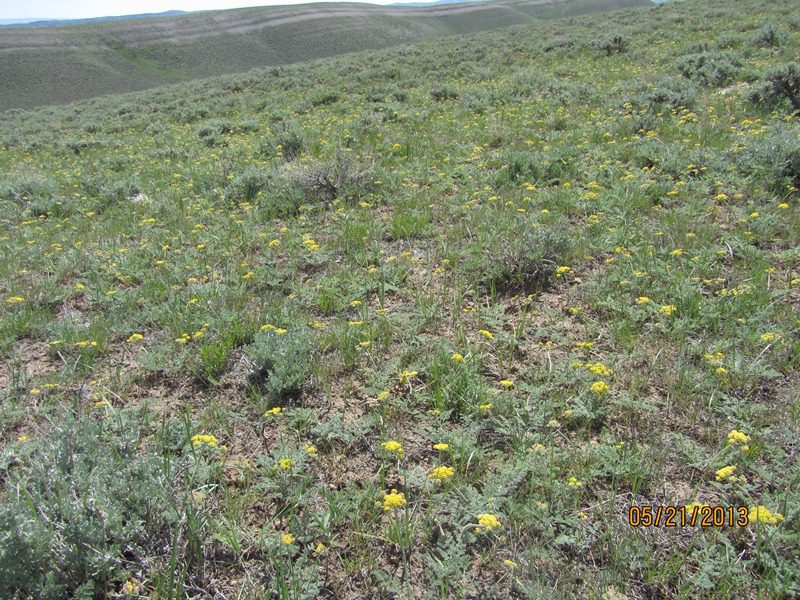
Figure 1.Bigseed biscuitroot plants growing with sagebrush and grasses in Wyoming. Photo: BLM WY050 Seeds of Success (SOS).
Bigseed biscuitroot is listed as a common species in several U.S. rangeland cover types (Shiflet 1994) including: 1) The bluebunch wheatgrass (Pseudoroegneria spicata) type that occurs throughout the Pacific Northwest, southern interior British Columbia, northeastern Oregon, eastern Washington, west- central Idaho, and western Montana where annual precipitation averages 8 to 20 in (200–510 mm); 2) The basin big sagebrush (Artemisia tridentata subsp. tridentata) type that has a broad western distribution, occurring where annual precipitation averages 8 to 14 in (200–360 mm), and soils are deep and permeable; and 3) The scabland sagebrush (A. rigida) type that occurs in eastern and central Washington and Oregon and extreme western Idaho at elevations of 700 to 4,000 ft (200–1,000 m) where annual precipitation averages 8 to 16 in (200–410 mm) and soils are shallow (usually <10 in [25 cm] deep) (Shiflet 1994).
In southern Alberta prairies, bigseed biscuitroot often co-occurs with common yarrow (Achillea millefolium) and rock-loving sandwort (Arenaria congesta var. lithophila) (Currah et al. 1983). In southern interior British Columbia, bigseed biscuitroot is common in bluebunch wheatgrass/big sagebrush (Artemisia tridentata), big sagebrush/Sandberg bluegrass (Poa secunda), bluebunch wheatgrass-Sandberg bluegrass, needle and thread (Hesperostipa comata)-bluebunch wheatgrass-Sandberg bluegrass, and cheatgrass (Bromus tectorum)-Sandberg bluegrass-needle and thread grassland communities (Tisdale 1947). In the southern Blue Mountains of Oregon, cover of bigseed biscuitroot was up to 5% in big sagebrush/Sandberg bluegrass-onespike danthonia (Danthonia unispicata) communities growing at 5,170 ft (1,580 m) in elevation where rock and gravel dominated the ground surface (Johnson and Swanson 2005). In central Nevada, bigseed biscuitroot constancy averaged 20% in ten late seral singleleaf pinyon-Utah juniper (Pinus monophylla–Juniperus osteosperma) stands with high tree cover (Everett and Koniak 1981).
Elevation
In the available literature, the elevation range for bigseed biscuitroot was reported for just California (490 to 9,840 ft [150–3,000 m]) (Hickman 1993) and Utah (4,860 to 8,370 ft [1,480–2,550 m]) (Welsh et al. 2016).
Soils
Bigseed biscuitroot commonly grows in dry, shallow, gravelly or rocky lithosols (Fig. 2) (Nelson 1918; Hermann 1966; Daubenmire 1970; Munz and Keck 1973; Taylor 1992; Hickman 1993; Maze and Robson 1996; Skinner et al. 2005). It is also found on serpentine (Hickman 1993) and basaltic talus soils (Mastrogiuseppe et al. 1985). In the Similkameen Valley in British Columbia, bigseed biscuitroot was found in all big sagebrush/bluebunch wheatgrass plots on well-drained loams to silt loams and in big sagebrush/needle and thread plots on shallow, gravelly, sandy soils. Constancy was slightly lower (85%) in ponderosa pine/Idaho fescue (Pinus ponderosa/Festuca idahoensis) plots on well-drained coarse sandy loams to sandy clay loams (McLean 1970). In eastern Washington, bigseed biscuitroot grew in the bluebunch wheatgrass-Sandberg bluegrass habitat type on shallow soils over bedrock (<14 in [35 cm] deep) (Daubenmire 1970). In the Crooked River National Grassland in Oregon’s Ochoco National Forest, the scabland sagebrush/Sandberg bluegrass-bigseed biscuitroot plant association occupied rocky, shallow (7–18 in [18–46 cm] to basalt bedrock), sandy to silt loam soils (Hopkins and Kovalchik 1983). In the central Siskiyou Mountains of California, bigseed biscuitroot was more frequent in low-elevation, serpentine communities along the xeric end of a moisture-gradient. It was absent from communities growing at the mesic end of the moisture gradient. Bigseed biscuitroot also grew in diorite, quartzite, and argillite soils but was most frequent in serpentine soils (Whittaker 1960).

Figure 2.Bigseed biscuitroot growing in sagebrush and pinyon-juniper vegetation on a rocky site in Oregon. Photo: BLM OR014 SOS.
Description
Bigseed biscuitroot is considered the most polymorphic species of the Lomatium genus (Figs. 4–7) (Mathias 1938). It grows as an acaulescent or short-caulesent perennial from a simple or sparingly branched crown with few or no persistent leaf bases (Jepson 1924; Munz and Keck 1973; Taylor 1992; Pendergrass 2010; Lesica 2012; Welsh et al. 2016). Roots are described as deep swollen taproots or irregularly shaped tubers (Fig. 3) (Ogle et al. 2014; Hitchcock and Cronquist 2018). Plants excavated from thin soils in southeastern Washington had long, fleshy, poorly branched taproots. They reached depths of 3 ft (0.9 m) or more and were usually flattened, folded, or twisted as they grew through narrow rock crevices (Weaver 1915). Plants typically exceed 4 in (10 cm) tall, are rarely more than 20 in (50 cm) tall but may reach 24 in (60 cm) tall when reproductively mature. Foliage ranges from glabrous to densely tomentose or villous and is purple tinged below (Mathias 1938; Munz and Keck 1973; Tilley et al. 2013; Hitchcock and Cronquist 2018).
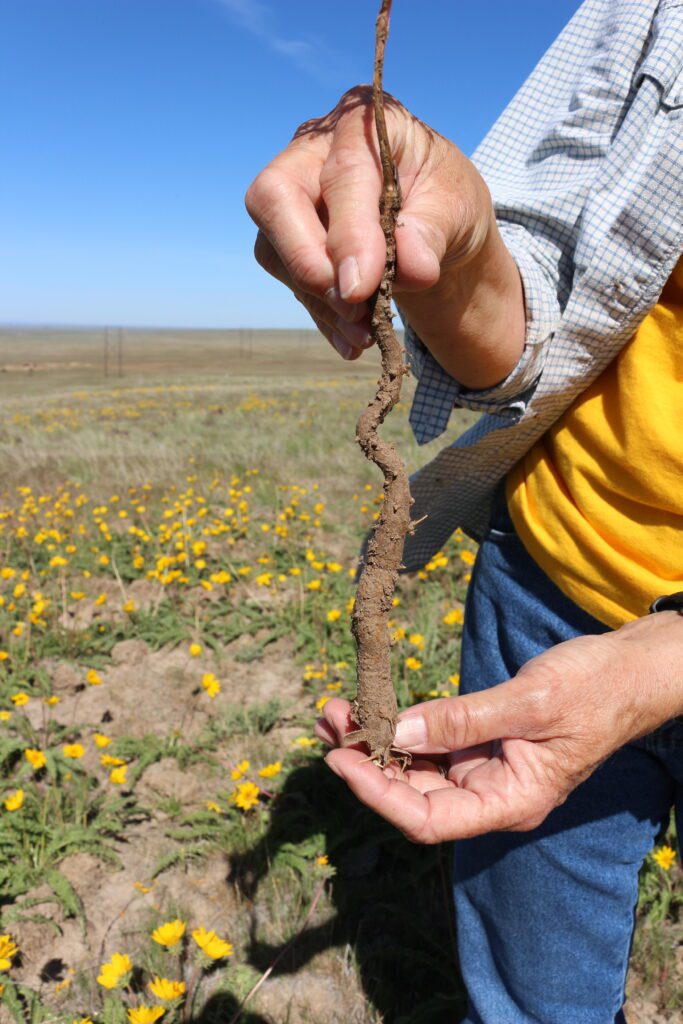
Figure 3. Bigseed biscuitroot taproot of a plant in Idaho. Photo: BLM ID931 SOS.
Plants are branched at the base, and stems are typically simple. Leaves are produced on the lower quarter of the stems, appearing clumped at the base (Coulter and Rose 1900; Goodrich 1986; Goodrich and Neese 1986; Taylor 1992; Welsh et al. 2016). Leaves are pinnately or ternate-pinnately compound (Figs. 4–5) usually with four opposite pairs of ovate to oblong lateral primary leaflets (1–2 in [3–6 cm] long). Leaf petioles are long (0.8–3 in [2–7 cm]) and taper above a dilated sheath. The lowest pair of primary leaflets are half to three-quarters as long as the leaf blades (Goodrich 1986; Welsh et al. 2016).
Ultimate leaf segments number 30 to 300 or more and are often less than 0.4 in (1 cm) long and up to four times as wide (Goodrich 1986; Lesica 2012; Welsh et al. 2016; Luna et al. 2018).
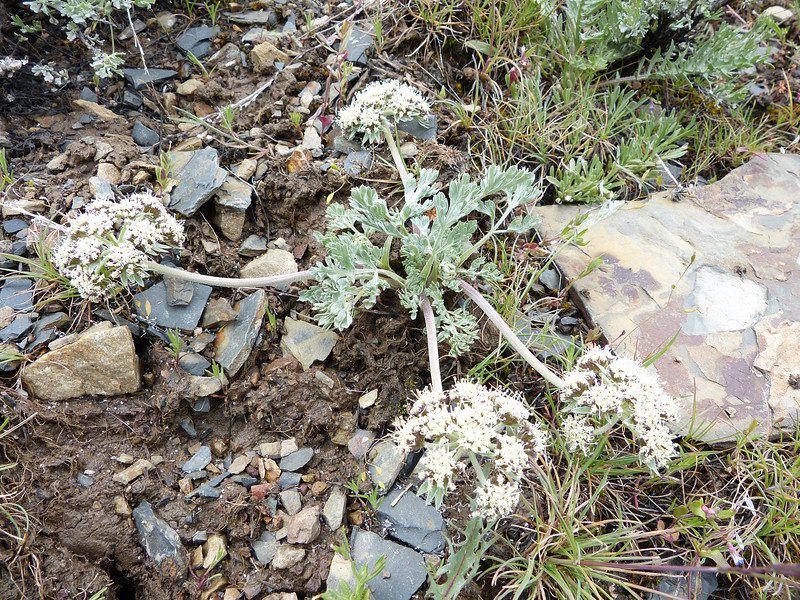
Figure 4. Bigseed biscuitroot plant growing in Nevada. Plant foliage is gray-green, leaves are dissected, and flowers are white. Photo: BLM NV020 SOS.
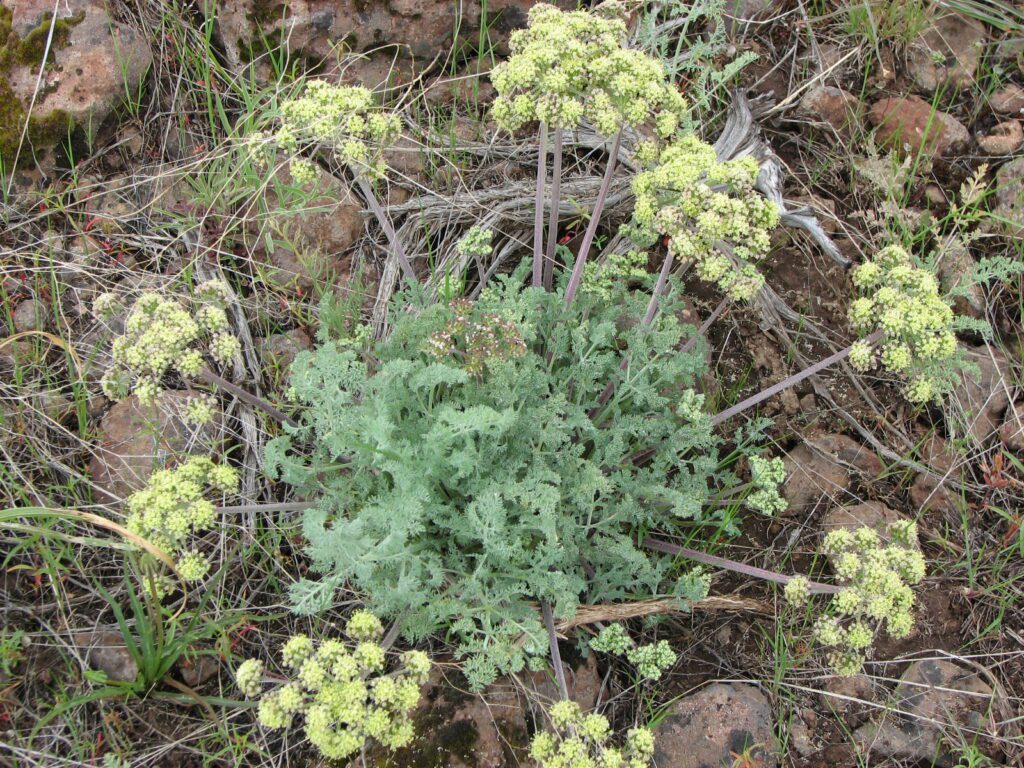
Figure 5.Bigseed biscuitroot plant growing in Oregon. Plant foliage is blue-green, leaves are finely dissected, and flowers are pale yellow. Photo: BLM OR014 SOS.
Flowers are produced in compound umbels borne on erect to laterally spreading stems (Mathias 1938; Currah et al. 1983; Taylor 1992). The primary umbel is comprised of 5 to 25 spreading rays that are 0.4 to 3 in (1–8.5 cm) long (Munz and Keck 1973; Hickman 1993). At the end of these rays are smaller umbellets with many tiny white to white-pink or yellow flowers (Tilley et al. 2013; Hitchcock and Cronquist 2018; Luna et al. 2018). Flowers borne at the ends of longer rays are generally bisexual, and those on shorter rays are mostly male flowers (Hitchcock and Cronquist 2018). The hub of the main umbel does not have leaf-like bracts or an involucre. Secondary umbellets are subtended by a whorl of leafy involucel bractlets (USFS 1937). Individual flowers produce white anthers and styles about 2 to 3 mm long (Welsh et al. 2016).
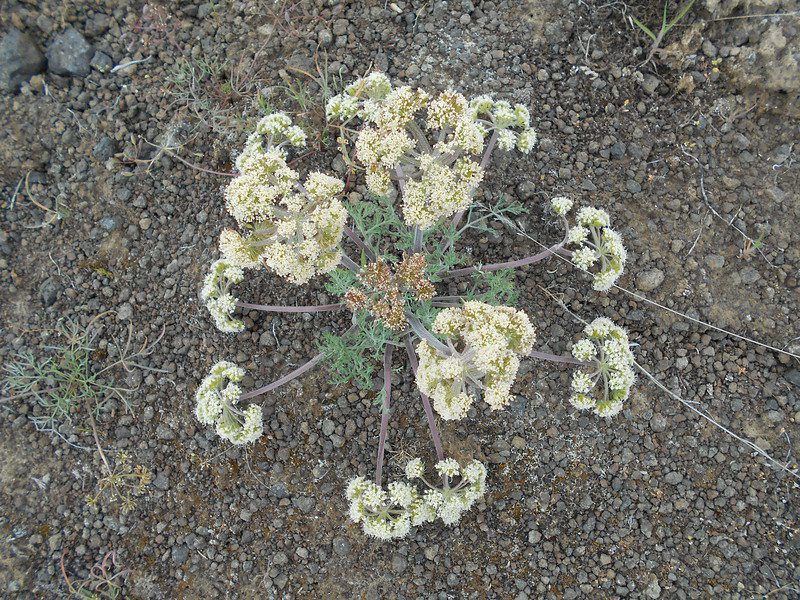
Figure 6. Compound umbels of bigseed biscuitroot with tiny white flowers. Photo: BLM OR135 SOS.
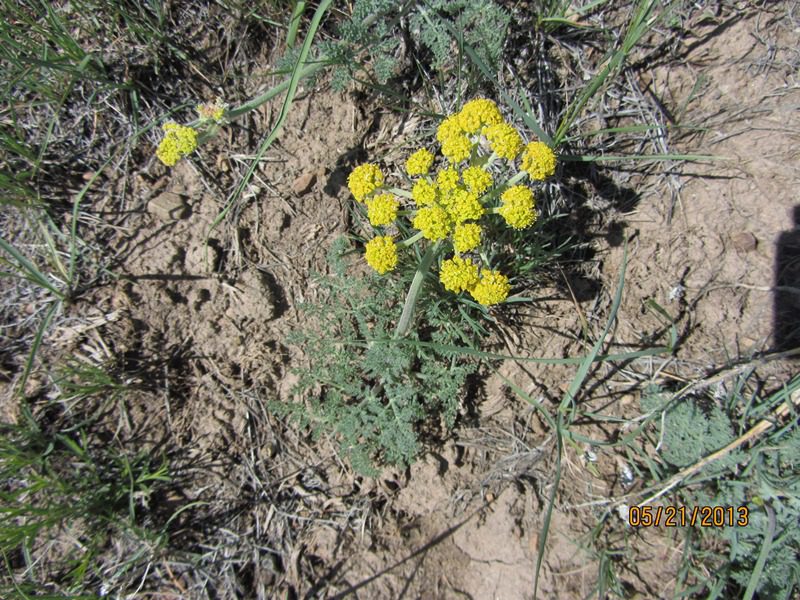
Figure 7. Compound umbel of bigseed biscuitroot with tiny bright yellow flowers. Photo: BLM WY050 SOS.
Bigseed biscuitroot produces fruits (schizocarps) comprised of two single-seeded mericarps that are attached face to face until maturity (USFS 1937; Currah et al. 1983). Individual mericarps (hereafter referred to as seeds) are narrow-oblong to elliptic and flattened. Seeds are 0.4 to 0.6 in (1–1.5 cm) long and two to five times long as wide (Hitchcock et al. 1961; Welsh et al. 2016). Seeds are brown to straw colored and glabrous with conspicuous lateral wings that are each about 30 to 75% the width of the seed body (Hickman 1993; Lesica 2012; Hitchcock and Cronquist 2018). The seed body is three-ribbed on one side (Currah et al. 1983).
Reproduction
Bigseed biscuitroot reproduces from seed, but plants may not produce seed every year. In grasslands of southeastern Washington and adjacent Idaho, Daubenmire (1942) found that plants persisted without reproducing for many years. Often non-reproductive plants remained so until competition from neighboring plants was reduced.
Estimated seed production was 1,000 seeds/plant for a single, mature, bigseed biscuitroot plant growing in North Dakota. The plant evaluated was average size with some aphid damage and growing without much plant competition (Stevens 1957).
Phenology
Bigseed biscuitroot is an early season plant that emerges in March or April, produces flowers as early as March and as late as June, and ripens seed in June and July (Munz and Keck 1973; Currah et al. 1983; Pitt and Wikeem 1990; Skinner et al. 2005). Phenology varies with precipitation and population location.
Flowering was later and longer in a dry year than a wet year in sagebrush steppe in south-central Washington. Flower buds were forming in early March, and flowering ended by May in the dry year of 1972–73 (5.3 in [135 mm] ppt). Flower buds and open flowers appeared in mid-March, and flowering ended in late May in the following wet year (15 in [375 mm] ppt) (Sauer and Uresk 1976).
Phenology tracking of plants showed slightly later development for those growing in southern British Columbia (Pitt and Wikeem 1990) compared to those growing near Dubois, Idaho (Blaisdell 1958). Plants in southern British Columbia were monitored for two years (1978 and 1979) with near normal temperatures and precipitation. Plants began growing in March and began flowering in March or April. Plants were in full flower in May and set and shattered seed in June. Plant were cured in July and did not regrow with fall moisture (Pitt and Wikeem 1990). Plants were monitored for 7 years (1941–47) near Dubois. The average date for growth initiation was April 11. Flower stalks first appeared on April 19. First blooms appeared on April 26, and the average date for full flower was May 7. Seed dissemination started on June 25 and was complete by July 20 (Blaisdell 1958).
Breeding System
Plants produce both male and bisexual flowers. Bisexual flowers are often produced on the longer rays while male flowers are produced on the shorter rays of the umbel (Hitchcock and Cronquist 2018).
Pollination
Good seed production requires pollination. Bigseed biscuitroot flowers are likely visited by a variety of pollinators (bees [Tilley et al. 2013], flies, moths, or butterflies [Murphy 1984]). It is a key nectar plant for Edith’s checkerspot (Euphydryas editha). At Jasper Ridge Biological Preserve on the Stanford University Campus, bigseed biscuitroot was the first plant to flower in the spring. On April 1, 50% to 90% of Edith’s checkerspot visits were to bigseed biscuitroot flowers even though they made up 10% or less of flowers available. All butterflies carried pollen (Murphy 1984).
Ecology
Bigseed biscuitroot is a long-lived perennial with a moderate growth rate (Tilley et al. 2013; Hitchcock and Cronquist 2018). It develops a strong taproot, and this, together with its early maturity and phenology (USFS 1937), suggests plants are drought and disturbance tolerant. A comparison of different aged old fields in southeastern Washington suggests that bigseed biscuitroot is a mid- to late-seral species (Daubenmire 1975; Simmons and Rickard 2002). Yet, researchers working in the Wyoming’s Wind River Range noted bigseed biscuitroot plants were associated with disturbed sites (Fertig et al. 2013).
Seed And Seedling Ecology
Seed predation and slow seedling growth are characteristic of bigseed biscuitroot. Abundance of seedlings was almost double in plots where rodents were excluded than in control plots (P < 0.05). This study was conducted in fescue-dominated grasslands in western Montana (Maron et al. 2012).
In a greenhouse study, the total biomass of bigseed biscuitroot seedlings was less than, but root-mass ratio was more than, that of other native species evaluated. Biomass was reduced by competition with other species (Parkinson et al. 2013). The total biomass of bigseed biscuitroot seedlings averaged 0.08 g at 12 weeks when grown alone. Biomass at 12 weeks was 0.06 g when grown with Sandberg bluegrass, and 0.05 g with bottlebrush squirreltail. The total biomass of bigseed biscuitroot seedlings was significantly lower with cheatgrass 0.04 g than alone (P < 0.05). Seedling biomass was significantly lower (P < 0.05) than that of all other native species tested (hoary tansyaster [Dieteria canescens], royal penstemon [Penstemon speciosus], sulphur-flower buckwheat [Eriogonum umbellatum] and Munro’s globemallow [Sphaeralcea munroana]). Yet, the root-mass ratio of bigseed biscuitroot seedlings was significantly higher than all other native seedlings (P < 0.05). Root mass of bigseed biscuitroot was entirely from taproots, no lateral roots had been developed. For this study, seeds were wild collected in southern Idaho, stratified for up to 12 weeks at 39 °F [4 °C], and germinated in a growth chamber (75 °F [24 °C] 14 hr light). Germinated seeds were planted in 6 × 18 in (16 × 45 cm) containers filled with a 1:1:1 mix of silt loam soil, washed concrete sand, and peat moss. In competition experiments, containers were planted with one of each seedling and kept in a greenhouse (64–75 °F [18–24 °C], 14 hr light) (Parkinson et al. 2013).
Disturbance Ecology
In the few studies comparing bigseed biscuitroot abundance on disturbed and undisturbed sites, plants were sensitive to grazing but increased following dormant-season fires. When vegetation was compared across fence lines and fire lines in several habitat types in the Columbia Basin of central Washington, bigseed biscuitroot was considered a decreaser on grazed sites in antelope bitterbrush (Purshia tridentata)/bluebunch wheatgrass communities and an increaser on burned sites in antelope bitterbrush/bluebunch wheatgrass and big sagebrush/bluebunch wheatgrass communities (Moomaw 1956).
Bigseed biscuitroot response to fire may depend on the timing of the fire. Abundance decreased following growing-season fires but increased after dormant-season fires. A spring prescribed fire (May 21) in basin big sagebrush in east-central Oregon reduced frequency of bigseed biscuitroot, yet a fall prescribed fire had no effect. Before the spring fire, frequency averaged 15%, and one year following the fire, frequency was 1%. The spring prescribed fire resulted in 84% mortality of sagebrush even with high fuel moistures (Kauffman et al. 1977). In rough fescue (Festuca campestris)-dominated foothills near Missoula, Montana, bigseed biscuitroot cover was similar or higher on burned than unburned plots following a June 28 fire. Cover of bigseed biscuitroot was 0.2% on unburned and 0.6% on burned plots in the first postfire year and 0.1% on unburned and 0.3% on burned plots in the second postfire year.
Differences were not significant (Antos et al. 1983). Similarly, cover of bigseed biscuitroot was unchanged after a late June fire burned rocky outcrops on the Arid Lands Ecology Reserve in Benton County, Washington. Cover was evaluated in the first post-fire year (Simmons and Rickard 2002).
Abundance of bigseed and cous biscuitroot (Lomatium cous) was greater on thinned, burned, and thinned and burned low-elevation forests in the northern Blue Mountains of northeastern Oregon. Cover (C) and frequency (F) were greatest on burned (31% F, 0.4% C), still high on thinned and burned (29% F, 0.3% C), a bit less on thinned (16% F, 0.3% C), and lowest on undisturbed (8% F, 0.3% C) plots. Forests were thinned in 1998 and burned in mid-September 2000. Effects were evaluated in 2003 (Youngblood et al. 2006).
Wildlife And Livestock Use
Bigseed biscuitroot is a forage plant for a diversity of wildlife, livestock, and insects (Tilley et al. 2013). Roots are eaten by bears (Ursus spp.) and rodents (Craighead et al. 1963). In the Bob Marshall Wilderness, Montana, bigseed biscuitroot roots received a high level of use by grizzly bears (Ursus arctos horribilis) (Mace and Bissell 1986). The plant is also eaten by black-tailed prairie dogs (Cynomys ludovicianus) and can make up to 5% of their spring diets (Martin et al. 1951).
Bigseed biscuitroot is important and palatable spring and summer forage for elk (Cervus canadensis), deer (Odocoileus spp.), pronghorn (Antilocapra americana), cattle, sheep, and horses (USFS 1937; Ogle and Brazee 2009). It is particularly valuable for sheep (Hermann 1966). Use by cattle was greater on burned and grazed than control plots in a big sagebrush grassland near Kamloops, British Columbia (Willms et al. 1980).
Lomatium species provide cover and food to greater sage-grouse (Centrocercus urophasianus). In the Hart Mountain National Antelope Refuge in Oregon and Nevada, Lomatium species provided cover and food for juveniles and adults (Pennington et al. 2016). Leaves of the plant and invertebrates in or on the flowers are consumed (Luna et al. 2018). In south-central Owyhee County, Idaho, Lomatium species were significantly (P = 0.023) more common in habitats used in the early than in the late brood-rearing period (Wik 2002).
Lomatium species are host plants for Indra swallowtails (Papilio indra) and anise swallowtails (P. zelicaon) (James and Nunnallee 2011). Bigseed biscuitroot is a key nectar plant for Edith’s checkerspot (Murphy 1984).
Nutritional Value
Researchers analyzed the fresh roots of bigseed biscuitroot that were collected during the preferred harvest season of Indigenous peoples in the Pacific Northwest. They reported the following dietary content: 16,320 kilojoules, 3.9 calories, 0.04 g protein, 0.89 g carbohydrate, 0.04 g ash, 0.02 g lipid, 1.65 mg calcium, 0.22 mg iron, 0.37 mg magnesium, and 0.02 mg zinc per gram of dry weight (Norton et al. 1984). For seeds, average oil content is 8.8% and protein content is 9.6% (SER, INSR, RBGK, SID 2023).
Ethnobotany
Western Indigenous peoples report high usage of bigseed biscuitroot as a food, medicine, ceremony, and mystical plant. Roots were gathered in large quantities, eaten raw or cooked alone or with other foods. Roots were ground into a meal, shaped into flat cakes, and taken on long journeys.
Roots were also dried and used as a chief article of trade (Craighead et al. 1963; Hart 1979; Turner et al. 1990).
Food. Songs of meadow larks (Sturnella neglecta) and robins (Turdus migratorius) were signals to the Secwepemc people that bigseed biscuitroot was ready for harvest (Turner and Bhattacharyya 2016). The Nlaka’pmx, Okanagan, Stl’atl’imx, and Secwepemc peoples typically harvested roots of non-fruiting plants, leaving the fruiting plants to reproduce. Tools made from mule deer antlers were used to dig the roots, which were typically harvested by women. Roots were dried and traded among Interior Plateau groups, especially from south to north (Turner 2005, 2014). Flathead Indians report that young, fresh roots were bitter tasting but became more palatable when dried. Older roots were considered too fibrous and stringy to eat. Crow Indians prepared the roots by roasting and scraping off the outer burnt crust (Hart 1976). Paiute Indians ate peeled roots raw or after baking them in hot ashes (Kelly 1932; Mahar 1953).
Thompson Indians in British Columbia harvest and grow bigseed biscuitroot (aka. Indian carrot) for immediate consumption and food storage (Turner et al. 1990). The roots were considered the “boss” of garden carrots and consumed in quantities by the end of 19th century. Roots were usually dug in spring, following flowering. They were used in a favorite dish made by boiling bigseed biscuitroot with tiger lily bulbs and fermented salmon roe but eating too many roots caused drowsiness (Turner et al. 1990).
Okanagan-Colville Indians dug roots in late June or early July, and good roots were 8 in (20 cm) or longer. Roots peeled and eaten raw tasted like celery leaves. Roots of non-flowering plants had a weaker flavor than those of flowering plants. Roots were also boiled or dried and stored for winter. Roots were pierced with a bone needle about 1 in (2.5 cm) from the top and strung to dry (Turner et al. 1980).
Medicine. Western Indigenous peoples prepared bigseed biscuitroot in many ways to treat illnesses, sores, and broken bones (Hart 1976; Turner et al. 1980). It was given as medicine to childless Thompson Indian men and women, and leaves were added to baths to help children sleep. Okanagan-Colville Indians chewed dried roots that had been soaked overnight to relieve cold, flu, and bronchitis symptoms. Soaked dry roots were pounded and put inside the mouths of infants to treat sores or thrush. Roots were mashed into a poultice to treat open wounds and broken bones (Turner et al. 1980). Flathead Indians chewed roots and swallowed the juice to soothe sore throats and drank a tea of root shavings and animal fat for colds. A poultice from boiled root shavings and a salve produced by boiling pulverized root shavings with melted tallow and a little water were used to treat swellings and sores.
Blackfeet Indians made a tea from roots and drank it when experiencing a weakened condition. Smoke and a decoction from burning roots was used to treat horse distemper (Hart 1976).
Ceremonial and more. Indians of the West report several ceremonial and other uses of bigseed biscuitroot (Hart 1976; Turner et al. 1990; Van Allen Murphey 1990; Turner 2014). Thompson Indians added leaves of this plant to cradles for padding. Roots were considered “good medicine” and provided powers. During storms, roots were chewed and spit against the wind to bring calm (Turner et al. 1990). Roots of the plant were said to be the father of one of the Salishan Transformers in the Child of Hog Fennel Story. The root father’s son grew up to be a transformer capable of travelling around the country with other supernatural beings and changing many different objects, plants, and animals into their present forms (Turner 2014). Flathead Indians sprinkled root shavings on live coals for ceremonial incense or to purify and deodorize the air (Hart 1976). Oregon tribes dried Lomatium flowers for use as perfume and carried seeds as a love charm (Van Allen Murphey 1990).
Horticulture
Bigseed biscuitroot seeds and plants can be found at select native plant nurseries. It is touted for rocky, dry conditions. It grows readily but slowly from seed after long stratification (Skinner et al. 2005). Its attractiveness to pollinators and as wildlife forage makes it a good choice for use at campsites, visitor centers, and other low or no maintenance natural landscapes.
Revegetation Use
Bigseed biscuitroot is recommended for revegetation of degraded or disturbed sites where annual precipitation averages 8 to 16 in (200–400 mm) (Tilley et al. 2013). It provides important early season forage and pollinator habitat (Eldredge et al. 2013; Ogle et al. 2014).
Developing A Seed Supply
For restoration to be successful, the right seed needs to be planted in the right place at the right time. Coordinated planning and cooperation is required among partners to first select appropriate species and seed sources and then properly collect, grow, certify, clean, store, and distribute seed for restoration (PCA 2015).
Developing a seed supply begins with seed collection from native stands. Collection sites are determined by current or projected revegetation requirements and goals. Production of nursery stock requires less seed than large-scale seeding operations, which may require establishment of agricultural seed production fields. Regardless of the size and complexity of any revegetation effort, seed certification is essential for tracking seed origin from collection through use (UCIA 2015).
Seed Sourcing
Because empirical seed zones are not currently available for bigseed biscuitroot, generalized provisional seed zones developed by Bower et al. (2014) may be used to select and deploy seed sources. These provisional seed zones identify areas of climatic similarity with comparable winter minimum temperature and aridity (annual heat to moisture index). In Figure 8, Omernik Level III Ecoregions (Omernik 1987) overlay the provisional seed zones to identify climatically similar but ecologically different areas. For site-specific disturbance regimes and restoration objectives, seed collection locations within a seed zone and ecoregion may be further limited by elevation, soil type, or other factors.
The Western Wildland Environmental Threat Assessment Center’s (USFS WWETAC 2017) Threat and Resource Mapping (TRM) Seed Zone application provides links to interactive mapping features useful for seed collection and deployment planning. The Climate Smart Restoration Tool (Richardson et al. 2020) can also guide revegetation planning, seed collection, and seed deployment, particularly when addressing climate change considerations.
Occurrence Map

Figure 8. Distribution of bigseed biscuitroot (black circles) based on geo-referenced herbarium specimens and observational data from 1833–2016 (CPNWH 2017; SEINet 2017; USDI USGS 2017). Generalized provisional seed zones (colored regions) (Bower et al. 2014) are overlain by Omernik Level III Ecoregions (black outlines) (Omernik 1987; USDI EPA 2018). Interactive maps, legends, and a mobile app are available (USFS WWETAC 2017; www.fs.fed.us/wwetac/threat-map/TRMSeedZoneMapper2.php?). Map prepared by M. Fisk, USDI USGS.
Releases
As of 2022, there were no bigseed biscuitroot germplasm releases.
Wildland Seed Collection
Because the seeds produced by many Lomatium species look alike, collections should be made when plants can be identified properly (Figs. 9 and 10). This often requires that plants still have their leaves and are flowering. Wildland seed is ready for harvest when seeds feel dry and papery and detach easily (Camp and Sanderson 2007).
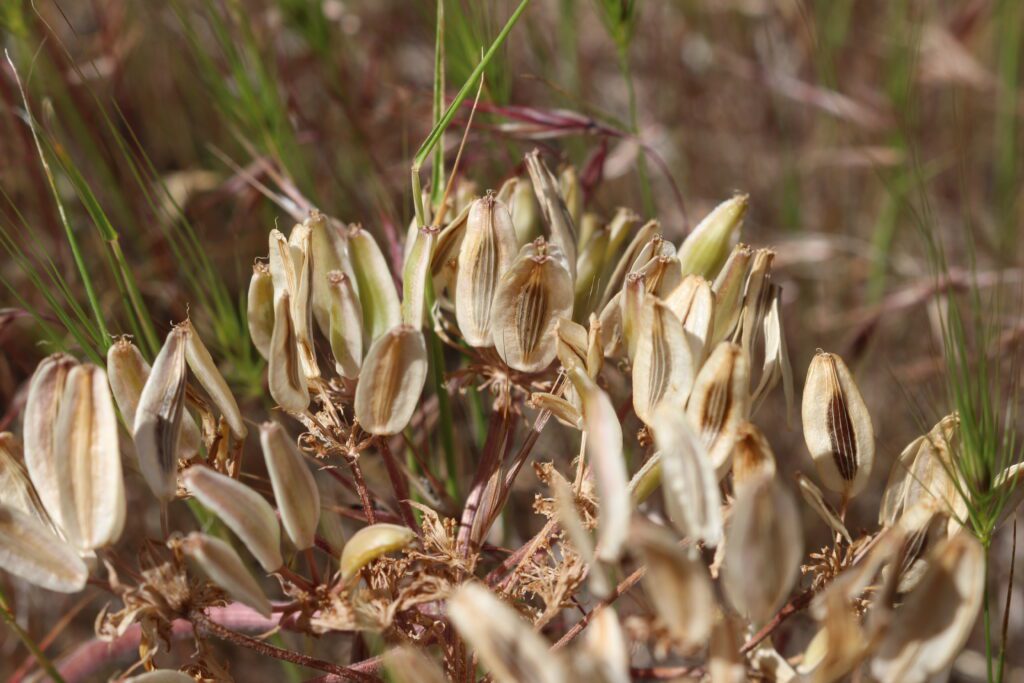
Figure 9. Bigseed biscuitroot seed ready for harvest in Idaho. Photo: BLM ID931 SOS.
Wildland Seed Certification
Verification of species and tracking of geographic source is necessary whether wildland seed is collected for immediate project use or as stock seed for cultivated increase. This official Source Identification process can be accomplished by following procedures established by the Association of Official Seed Certifying Agencies (AOSCA) Pre-Variety Germplasm Program (UCIA 2015; Young et al. 2020). Wildland seed collectors should become acquainted with state certification agency procedures, regulations, and deadlines in the states where they collect.
If wildland-collected seed is to be sold for direct use in ecological restoration projects, collectors must apply for Source-Identified certification prior to making collections. Pre-collection applications, site inspections, and species and seed amount verification are handled by the AOSCA member state agency where seed collections will be made (see listings at AOSCA.org).
If wildland seed collected by a grower or private collector is to be used as stock seed for planting cultivated seed fields or for nursery propagation (See Agricultural Seed Field Certification section), detailed information regarding collection site and collecting procedures must be provided when applying for certification. Photos and herbarium specimens may be required. Germplasm accessions acquired within established protocols of recognized public agencies, however, are normally eligible to enter the certification process as stock seed without routine certification agency site inspections. For contract grow-outs, however, this collection site information must be provided to the grower to enable certification.
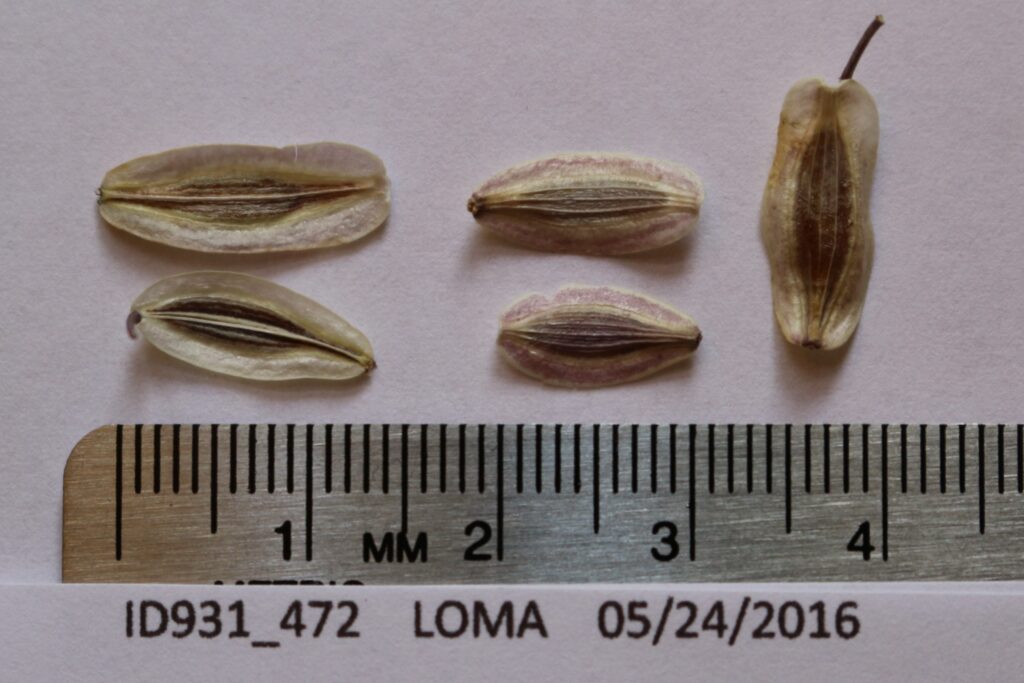
Figure 10. Individual bigseed lomatium seeds (mericarps), note the variability in size. Photo: BLM ID931 SOS.
Collection Timing
Camp and Sanderson (2007) and USDI BLM SOS (2017) report that wildland seed is often collected in June or July, although collections were made as early as April and May and as late as August and September. The Bureau of Land Management’s Seeds of Success crews made 16 collections of bigseed biscuitroot over 14 years between 2002 to 2016 (USDI BLM SOS 2017). Harvests were made in California (2), Oregon (7), Washington (3), Idaho (2), Nevada (1), and Wyoming (1). Just one collection was made in April, one in May, eight in June, four in July, one in August, and one in September. The earliest collection was April 29, 2015, in Lincoln County, Washington, at 1,650 ft (500 m) in elevation. The latest collection was September 10, 2010, in Klamath County, Oregon, at 5,338 ft (1,627 m) in elevation (USDI BLM SOS 2017). Camp and Sanderson (2007) harvested bigseed biscuitroot seed in early June at an elevation of 710 ft (216 m) in Gilliam County, Oregon. In a seven-year phenology study (1941–47) near Dubois, Idaho, the average date of seed maturity was June 29 and seed dispersal was July 20 (Blaisdell 1958).
Collection Methods
Several collection guidelines and methods should be followed to maximize the genetic diversity of wildland collections: 1) collect seed from a minimum of 50 randomly selected plants; 2) collect from widely separated individuals throughout a population without favoring the most robust or avoiding small stature plants; and 3) collect from all microsites including habitat edges (Basey et al. 2015). General collecting recommendations and guidelines are provided in online manuals (e.g., ENSCONET 2009; USDI BLM SOS 2021).
It is critical that wildland seed collection does not impact the sustainability of native plant populations. Collectors should take no more than 20% of the viable seed available at the time of harvest (USDI BLM SOS 2021). Additionally, care must be taken to avoid the inadvertent collection of weedy species, particularly those that produce seeds similar in shape and size to those of bigseed biscuitroot.
Collection Rates
Widland harvests using hand-stipping methods are moderately time consuming (Camp and Sanderson 2007).
Post-Collection Management
Seed (Fig. 10) should be kept in a dry, shaded place until collections can be moved to a controlled short-term storage environment. Short-term storage should be dry, cool, and inaccessible to rodents or other seed predators. If insects are suspected in any collection, seed should be frozen for 48 hours or treated with an appropriate insecticide. The more plant material in the collection, the more ventilation and drying a seed lot will likely need (Gold n.d.; Parkinson and DeBolt 2005; Hay and Probert 2011).
Seed Cleaning
Procedures for cleaning bigseed biscuitroot seed were not reported in the available literature (Fig. 11). The Bend Seed Extractory shared their procedure for cleaning a 3.5 lb (1.6 kg) harvest of similar barestem biscuitroot (L. nudicaule) seed. Seed was hand-collected in paper bags from the Umatilla National Forest near Ukiah, Oregon. Seed was first processed using a Westrup Model LA-H laboratory brush machine (Corvallis, OR) with a #20 mantel and medium speed. Seeds (mericarps) of barestem biscuitroot were then air-screened using an office Clipper (Bluffton, IN) with a 24 round top screen, 8 round bottom screen, medium speed, and low to medium air (Barner 2009).
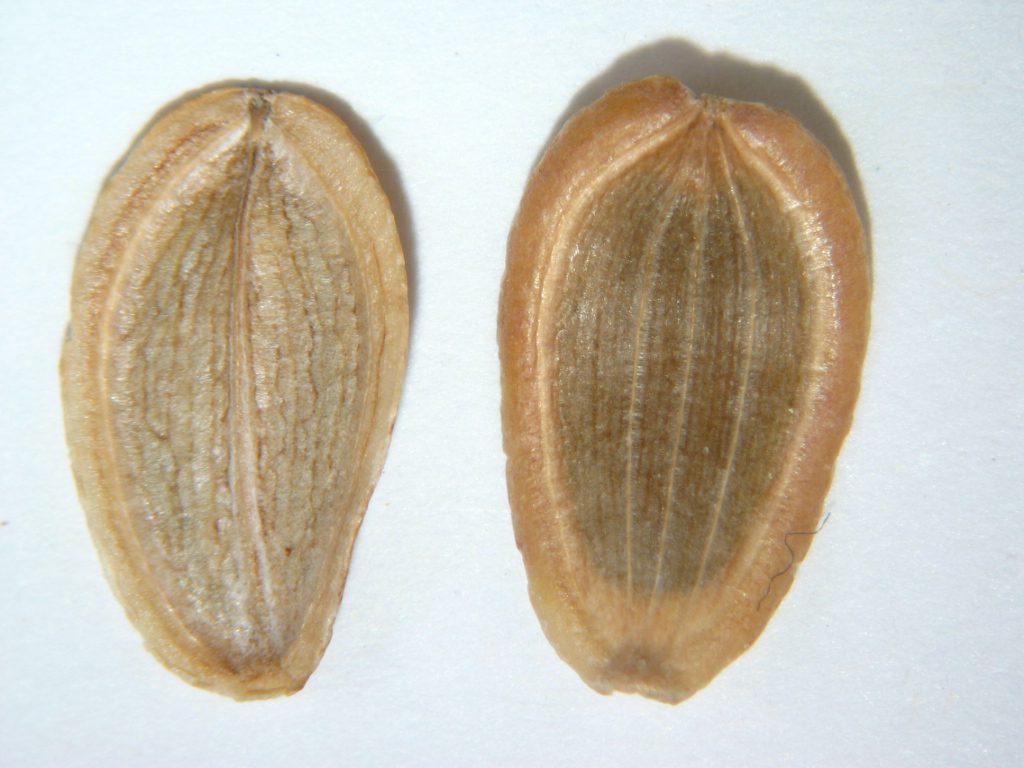
Figure 11. Clean bigseed biscuitroot seed (mericarps) under magnification. Photo: USFS Bend Seed Extractory.
Seed Storage
Bigseed biscuitroot seed is orthodox. Dry seed retained 90% viability after eight months of storage at -4 °F (-20 °C), but original seed viability was not reported (SER, INSR, RBGK, SID 2023).
Seed Testing
There is no Association of Official Seed Analysts (AOSA) rule for testing germination of bigseed biscuitroot.
Viability Testing
Because no Association of Official Seed Analysts (AOSA) tetrazolium chloride viability procedure exists for Lomatium species, viability procedures should follow those developed for the Apiaceae family. Seed is first imbibed on moist media for 16 hours at 68 to 77 ˚F (20–25 ˚C). Because of deep seed dormancy, bigseed biscuitroot seed should be clipped and soaked in gibberellic acid (GA3) overnight before staining. Seed is then cut laterally or longitudinally and exposed to tetrazolium (TZ) concentrations of 0.1 or 1% at 68 to 95 ˚F (20–35 ˚C) for 4 hours or overnight. Staining evaluation varies by species and was not reported for Lomatium specifically (AOSA 2010).
Germination Testing
The limited number of studies available for bigseed biscuitroot indicate that cold incubation temperatures or cold stratification treatments improve germination of the deeply dormant seed (AOSA 2010). Bartow (2015) reported that germination improved with 45 to 90 days of cold stratification. Love and Akins (2019) reported 80% germination after 42 to 77 days at 40 °F (4 °C). Germination was much lower (4%) for seed exposed to temperatures of 70 °F (20 °C) for 90 days followed by 40 °F (4 °C) for 90 days. Sixty-two percent of seed put outdoors in Pennsylvania in December germinated in February (Love and Akins 2019).
Germination Biology
The limited number of studies available for bigseed biscuitroot indicate that cold incubation temperatures or cold stratification treatments improve germination of the deeply dormant seed (AOSA 2010). Bartow (2015) reported that germination improved with 45 to 90 days of cold stratification. Love and Akins (2019) reported 80% germination after 42 to 77 days at 40 °F (4 °C). Germination was much lower (4%) for seed exposed to temperatures of 70 °F (20 °C) for 90 days followed by 40 °F (4 °C) for 90 days. Sixty-two percent of seed put outdoors in Pennsylvania in December germinated in February (Love and Akins 2019).
Wildland Seed Yield And Quality
Post-cleaning seed yield and quality of seed lots collected in the Intermountain region are provided in Table 1 (USFS BSE 2017). The results indicate that bigseed biscuitroot seed can generally be cleaned to moderately high levels of purity and seed fill and that viability of fresh seed can vary.
Table 1. Seed yield and quality of bigseed biscuitroot seed lots collected in the Intermountain region, cleaned by the Bend Seed Extractory, and tested by the Oregon State Seed Laboratory or the USFS National Seed Laboratory (USFS BSE 2017).
| Seed lot characteristic | Mean | Range | Samples (no.) |
| Bulk weight (lbs) | 1.25 | 0.33–3.7 | 18 |
| Clean weight (lbs) | 0.69 | 0.05–1.1 | 18 |
| Clean-out ratio | 0.53 | 0.06–0.7 | 18 |
| Purity (%) | 91.8 | 73–99 | 18 |
| Fill (%)1 | 89.6 | 85–97 | 18 |
| Viability (%)2 | 88.2 | 77–95 | 10 |
| Seeds/lb | 34,335 | 4,600–63,000 | 18 |
| Pure live seeds/lb | 20,355 | 3,636–41,391 | 10 |
¹100 seed X-ray test
²Tetrazolium chloride test
Marketing Standards
Acceptable seed purity, viability, and germination specifications vary with revegetation plans. Purity needs are highest for precision seeding equipment used in nurseries, while some rangeland seeding equipment handles less clean seed quite well.
Agricultural Seed Production
Procedures for farming bigseed biscuitroot experimentally or commercially was not reported in the literature. See the other Lomatium species reviews for guidance.
Agricultural Seed Certification
In order to minimize genetic changes in specific accessions of native species when increased in cultivated fields, it is essential to track the geographic source and prevent inadvertent hybridization or selection pressure. This tracking is accomplished by following third party seed certification protocols for Pre-Variety Germplasm (PVG) as established by the Association of Official Seed Certification Agencies (AOSCA). AOSCA members in the U.S., Canada, and other countries administer PVG requirements and standards that track the source and generation of planting stock. Field and cleaning facility inspections then monitor stand establishment, proper isolation distances, control of prohibited weeds, seed harvesting, cleaning, sampling, testing, and labeling for commercial sales (UCIA 2015; Young et al. 2020).
Seed growers apply for certification of their production fields prior to planting and plant only certified stock seed of an allowed generation (usually less than four). The systematic and sequential tracking through the certification process requires preplanning, knowing state regulations and deadlines, and is most smoothly navigated by working closely with state certification agency personnel. See the Wildland Seed Certification section for more information on stock seed sourcing.
Nursery Practice
Bigseed biscuitroot was propagated at Derby Canyon Natives in Peshastin, Washington, using the following procedures (Camp and Sanderson 2007). Seed was sown outdoors in 4-in³ (66 cm³) containers filled with a 45:30:35 mix of peat, vermiculite, and sand in early November. Seed was covered lightly with sand and remained outside for four months starting in November. In March, containers were moved into a greenhouse until early April when they were moved outside again. Initial germination of bigseed biscuitroot was 91%, and 73% of seedlings survived to early May (Camp and Sanderson 2007).
Wildland Seeding And Planting
Bigseed biscuitroot is recommended for pollinator habitat at sites receiving 8 to 16 in (200–400 mm) annual precipitation (Tilley et al. 2013; Ogle et al. 2014). The recommended pure stand seeding rate is 10 to 11 lbs/ac (11–12 kg/ha) and seeding depth is 0.1 to 0.5 in (0.3–1.3 cm). The seedling growth rate is slow, so this species should be sown with other slow growing species separate from rapidly growing grasses (Tilley et al. 2013; Ogle et al. 2014).
Acknowledgements
Funding for Western Forbs: Biology, Ecology, and Use in Restoration was provided by the USDI BLM Great Basin Native Plant Materials Ecoregional Program through the Great Basin Fire Science Exchange. Great thanks to the chapter reviewers: Robert Cox, Professor, Texas Tech University, and Lesley DeFalco, Supervisory Plant Ecologist, USGS.
This research was supported in part by the USDA Forest Service, Rocky Mountain Research Station. The findings and conclusions in this publication are those of the authors and should not be construed to represent any official USDA or U.S. Government determination or policy.
Literature Cited
Antos, J.A.; McCune, B.; Bara, C. 1983. The effect of fire on an ungrazed western Montana grassland. The American Midland Naturalist. 110(2): 354-364.
Association of Official Seed Analysts [AOSA]. 2010. AOSA/SCST Tetrazolium testing handbook. Contribution No. 29. Lincoln, NE: Association of Official Seed Analysts.
Baker, W.H. 1956. Plants of Iron Mountain, Rogue River Range, Oregon. American Midland Naturalist. 56(1): 1-53.
Barner, J. 2009. Propagation protocol for production of container (plug) Lomatium nudicaule Pursh. seeds. Native Plant Network. U.S. Department of Agriculture, Forest Service, National Center for Reforestation, Nurseries, and Genetic Resources. http://npn.rngr.net/propagation/protocols [Accessed 2020 July 1].
Bartow, A. 2015. Propagation protocol for production of container (plug) Lomatium macrocarpum. Native Plant Network. U.S. Department of Agriculture, Forest Service, National Center for Reforestation, Nurseries, and Genetic Resources. http://npn.rngr.net/propagation/protocols [Accessed 2020 May 22].
Basey, A.C.; Fant, J.B.; Kramer, A.T. 2015. Producing native plant materials for restoration: 10 rules to collect and maintain genetic diversity. Native Plants Journal. 16(1): 37-53.
Bell, C.R.; Constance, L. 1957. Chromosome numbers in Umbelliferae. American Journal of Botany. 44(7): 565-572.
Blaisdell, J.P. 1958. Seasonal development and yield of native plants on the Upper Snake River Plains of Idaho and their relation to climatic factors, especially precipitation and temperature. Tech. Bull. 1190. Washington, DC: U.S. Department of Agriculture. 68 p.
Bower, A.D.; St. Clair, J.B.; Erickson, V. 2014. Generalized provisional seed zones for native plants. Ecological Applications. 24(5): 913-919.
Camp, P.; Sanderson, J. 2007. Seed collection, propagation and reintroduction of native wildflowers in the Columbia Basin. Wenatchee, WA: U.S. Department of the Interior, Bureau of Land Management, Wenatchee Field Office. 32 p.
Consortium of Pacific Northwest Herbaria [CPNWH]. 2017. Seattle, WA: University of Washington Herbarium, Burke Museum of Natural History and Culture. http://www.pnwherbaria.org/index.php
Coulter, J.M.; Rose, J.N. 1900. Monograph of the North American Umbelliferae. Systematic and Geographic Botany and Aboriginal Uses of Plants. 7(1): 9-256.
Craighead, J.J.; Craighead, F.C. Jr.; Davis, R.J. 1963. A field guide to Rocky Mountain wildflowers from northern Arizona and New Mexico to British Columbia. Boston, MA: Houghton Mifflin Company. 277 p.
Currah, R.; Smreciu, A.; Van Dyk, M. 1983. Prairie wildflowers: An illustrated manual of species suitable for cultivation and grassland restoration. Edmonton, AB: University of Alberta, Friends of the Devonian Botanic Garden. 290 p.
Daubenmire, R. 1970. Steppe vegetation of Washington. Washington Agricultural Experiment Station Tech. Bull. 62. Pullman, WA: Washington State University. 131 p.
Daubenmire, R. 1975. Plant succession on abandoned fields, and fire influences, in a steppe area in southeastern Washington. Northwest Science. 49(1): 36-48.
Daubenmire, R.F. 1942. An ecological study of the vegetation of southeastern Washington and adjacent Idaho. Ecological Monographs. 12(1): 53-79.
Eldredge, E.; Novak-Echenique, P.; Heater, T.; Mulder, A.; Jasmine, J. 2013. Plants for pollinator habitat in Nevada. Tech. Note NV 57. Reno, NV: U.S. Department of Agriculture, Natural Resources Conservation Service. 65 p.
European Native Seed Conservation Network [ENSCONET]. 2009. ENSCONET seed collecting manual for wild species. Edition 1: 32 p.
Everett, R.L.; Koniak, S. 1981. Understory vegetation in fully stocked pinyon-juniper stands. Great Basin Naturalist. 41(4): 467-475.
Fertig, W.F.; Massatti, R.T.; Nelson, B.E.; Hartman, R.L. 2013. Annotated checklist of the vascular flora of the Wind River Range, Wyoming (U.S.A.). Journal of the Botanical Research Institute of Texas. 7(2): 905-939.
Gold, K. n.d. Post-harvest handling of seed collections. Technical Information Sheet 04. UK: Royal Botanic Gardens Kew and Millennium Seed Bank Partnership. 4 p.
Goodrich, S. 1986. Utah Flora: Apiaceae (Umbelliferae). Great Basin Naturalist. 46(1): 66-106.
Goodrich, S.; Neese, E. 1986. Uinta Basin flora. Ogden, UT: U.S. Department of Agriculture, Forest Service, Intermountain Region. 320 p.
Hart, J. 1976. Montana native plants and early peoples. Helena, MT: Montana Historical Society Press. 152 p.
Hart, J.A. 1979. The ethnobotany of the Flathead Indians of western Montana. Botanical Museum Leaflets, Harvard University. 27(10): 261-307.
Hay F.R.; Probert, R.J. 2011. Chapter 20: Collecting and handling seeds in the field. In: Guarino, L.; Ramanatha, V.; Goldberg, E. Collecting plant genetic diversity: Technical Guidelines-2011 update. Rome, Italy: Bioversity International. 33 p.
Hermann, F. 1966. Notes on western range forbs: Cruciferae through Compositae. Agric. Handb. 293. Washington, DC: U.S. Department of Agriculture, Forest Service. 365 p.
Hickman, J.C., ed. 1993. The Jepson manual: Higher plants of California. Berkeley, CA: University of California Press. 1400 p.
Hitchcock, C.L.; Cronquist, A. 2018. Flora of the Pacific Northwest: An illustrated manual. Second Ed. Giblin, D.E.; Legler, B.S.; Zika, P.F.; Olmstead, R.G., eds. Seattle, WA: University of Washington Press. 882 p.
Hitchcock, C.L.; Cronquist, A.; Ownbey, M.; Thompson, J.W. 1955. Vascular plants of the Pacific Northwest. Part 3: Saxifragaceae to Ericaceae. Seattle, WA: University of Washington Press. 614 p.
Hopkins, W.E.; Kovalchik, B.L. 1983. Plant associations of the Crooked River National Grassland, Ochoco National Forest. R6 Ecol 133-1983. Portland, OR: U.S. Department of Agriculture, Forest Service, Pacific Northwest Region. 97 p.
ITIS Database. 2022. Integrated Taxonomic Information System. Available: http://www.itis.gov/index.html
James, D.G.; Nunnallee, D. 2011. Life histories of Cascadia butterflies. Corvallis, OR: Oregon State University Press. 447 p.
Jepson, W.L. 1923. A revision of Californian Umbelliferae. III. Continued. Madrono. 1(8): 133-146.
Jepson, W.L. 1924. A revision of Californian Umbelliferae. IV. Continued. Madrono. 1(9): 149-162.
Johnson, C.G.; Swanson, D.K. 2005. Bunchgrass plant communities of the Blue and Ochoco Mountains: A guide for managers. Gen. Tech. Rep. PNW-GTR-641. Portland, OR: U.S. Department of Agriculture, Forest Service, Pacific Northwest Research Station. 119 p.
Kauffman, J.B.; Sapsis, D.B.; Till, K.M. 1977. Ecological studies of fire in sagebrush/bunchgrass ecosystems of the John Day Fossil Beds National Monument, Oregon: Implications for the use of prescribed burning to maintain natural ecosystems. Seattle, WA: National Park Service, Columbia Cascades System Support Office. 148 p.
Kelly, I.T. 1932. Ethnography of the Surprise Valley Paiute. University of California Publications in American Archaeology and Ethnology. 31(3): 67-210.
Lesica, P. 2012. Manual of Montana vascular plants. Fort Worth, TX: Botanical Research Institute of Texas (BRIT) Press. 779 p.
Love, S.L.; Akins, C.J. 2019. Fourth summary of the native seed germination studies of Norman C Deno: Species with names beginning with letters L through O. Native Plants. 20(3): 279-305.
Luna, T.; Mousseaux, M.R.; Dumroese, R.K. 2018. Common native forbs of the northern Great Basin important for greater sage-grouse. Gen. Tech. Rep. RMRS-GTR-387. Fort Collins, CO: U.S. Department of Agriculture, Forest Service, Rocky Mountain Research Station; Portland, OR: U.S. Department of the Interior, Bureau of Land Management, Oregon-Washington Region. 76 p.
Mace, R.D.; Bissell, G.N. 1986. Grizzly bear food resources in the flood plains and avalanche chutes of the Bob Marshall Wilderness, Montana. In: Contreras, G.P.; Evans, K.E., comps. Proceedings–grizzly bear habitat symposium; 1985 April 30 – May 2. Missoula, MT: Gen. Tech. Rep. INT-207. Ogden, UT: U.S. Department of Agriculture, Forest Service, Intermountain Research Station: 78-91.
Mahar, J.M. 1953. Ethnobotany of the Oregon Paiutes of the Warm Springs Indian Reservation. Portland, OR: Reed College. Thesis. 143 p.
Maron, J.L.; Pearson, D.E.; Potter, T.; Ortega, Y.K. 2012. Seed size and provenance mediate the joint effects of disturbance and seed predation on community assembly. Journal of Ecology. 100(6): 1492-1500.
Martin, A.C.; Zim, H.S.; Nelson, A.L. 1951. American wildlife and plants: A guide to wildlife food habits. New York, NY: Dover Publications. 500 p.
Mastrogiuseppe, J.D.; Gill, S.J.; Simmons, K.S.; Brown, G.K. 1985. Morphologic and cytotaxonomic evaluation of Lomatium tuberosum (Apiaceae). Brittonia. 37(3): 252-260.
Mathias, M.E. 1938. A revision of the genus Lomatium. Annals of the Missouri Botanical Garden. 25(1): 225-297.
Maze, J.; Robson, K.A. 1996. A new species of Achnatherum (Oryzopsis) from Oregon. Madrono. 43(3): 393-403.
McLean, A. 1970. Plant communities of the Similkameen Valley, British Columbia, and their relationships to soils. Ecology. 40(4): 403-424.
Moomaw, J.C. 1956. Some effects of grazing and fire on vegetation in the Columbia Basin region, Washington. Pullman, WA: Washington State University. Dissertation. 87 p.
Munz, P.A.; Keck, D.D. 1973. A California flora and supplement. Berkeley, CA: University of California Press. 1905 p.
Murphy, D.D. 1984. Butterflies and their nectar plants: The role of the checkerspot butterfly Euphydryas editha as a pollen vector. Oikos. 43(1): 113-117.
Nelson, J.C. 1918. Additions to the flora of western Oregon. Torreya. 18(2): 21-35.
Norton, H.H.; Hunn, E.S.; Martinsen, C.S.; Keely, P.B. 1984. Vegetable food products of the foraging economies of the Pacific Northwest. Ecology of Food and Nutrition. 14(3): 219-228.
Ogle, D., Tilley, D., St. John, L., Stannard, M., and Holzworth, L. 2014. Conservation plant species for the Intermountain West. Plant Materials Technical Note 24. Boise, ID: U.S. Department of Agriculture, Natural Resources Conservation Service. 72 p.
Ogle, D.; Brazee, B. 2009. Estimating initial stocking rates. Range Tech. Note 3. Boise, ID: U.S. Department of Agriculture, Natural Resources Conservation Service. 11 p.
Omernik, J.M. 1987. Ecoregions of the conterminous United States. Map (scale 1:7,500,000). Annals of the Association of American Geographers. 77(1): 118-125.
Parkinson, H.; DeBolt, A. 2005. Propagation protocol for production of container (plugs) Lomatium triternatum (Pursh.) Coult. & Rose seeds. Native Plant Network. U.S. Department of Agriculture, Forest Service, National Center for Reforestation, Nurseries, and Genetic Resources. http://npn.rngr.net/propagation/protocols [Accessed 2020 July 1].
Parkinson, H.; Zabinski, C.; Shaw, N. 2013. Impact of native grasses and cheatgrass (Bromus tectorum) on Great Basin forb seedling growth. Rangeland Ecology and Management. 66(2): 174-180.
Pendergrass, K. 2010. Introduction to Cook’s lomatium, a federally-listed endangered species, and a key and photo guide to the Lomatium species that occur within its range. Portland, OR: US Department of Agriculture, Natural Resources Conservation Service. 23 p.
Pennington, V.E.; Schlaepfer, D.R.; Beck, J.L.; Bradford, J.B.; Palmquist, K.A.; Lauenroth, W.K. 2016. Sagebrush, greater sage-grouse, and the occurrence and importance of forbs. Western North American Naturalist. 76(3): 298-312.
Pitt, M.; Wikeem, B.M. 1990. Phenological patterns and adaptations in an Artemisia/Agropyron plant community. Journal of Range Management. 43(4): 350-358.
Plant Conservation Alliance [PCA]. 2015. National seed strategy for rehabilitation and restoration 2015-2020. Washington, DC: U.S. Department of the Interior, Bureau of Land Management. 52 p.
Richardson, B.; Kilkenny, F.; St. Clair, B.; Stevenson-Molnar, N. 2020. Climate Smart Restoration Tool. https://climaterestorationtool.org/csrt/
Sauer, R.H.; Uresk, D.W. 1976. Phenology of steppe plants in wet and dry years. Northwest Science. 50(3): 133-139.
SEINet – Regional Networks of North American Herbaria Steering Committee [SEINet]. 2017. SEINet Regional Networks of North American Herbaria. https://symbiota.org/seinet
Sharsmith, H.K. 1945. Flora of the Mount Hamilton Range of California (A taxonomic study and floristic analysis of the vascular plants). American Midland Naturalist. 34(2): 289-367.
Shiflet, T.N. 1994. Rangeland cover types of the United States. Denver, CO: Society for Range Management. 152 p.
Simmons, S.A.; Rickard, W.H. 2002. Plant succession at the edges of two abandoned cultivated fields on the Arid Lands Ecology Reserve. Northwest Science. 76(1): 85-89.
Skinner, D.M.; Warnick, P.; French, B.; Fauci, M. 2005. More Palouse forbs for landscaping. Pullman, WA: U.S. Department of Agriculture, Natural Resources Conservation Service. 7 p.
Society for Ecological Restoration; International Network for Seed Based Restoration; Royal Botanic Gardens [SER, INSR, RBGK]. 2023. Seed Information Database (SID). Available from: https://ser-sid.org/
Stevens, O.A. 1957. Weights of seeds and numbers per plant. Weeds. 5(1): 46-55.
Taylor, R.J. 1992. Sagebrush country: A wildflower sanctuary. Missoula, MT: Mountain Press Publishing Company. 211 p.
Tilley, D.; Taliga, C.; Burns, C.; St. John, L. 2013. Plant materials for pollinators and other beneficial insects in eastern Utah and western Colorado. Tech. Note 2C. Boise, ID: U.S. Department of Agriculture, Natural Resources Conservation Service. 54 p.
Tisdale, E.W. 1947. The grasslands of the southern Interior of British Columbia. Ecology. 28(4): 346-382.
Turner, N.J. 2005. The Earth’s blanket: Traditional teachings for sustainable living. Seattle, WA: University of Washington Press. 304 p.
Turner, N.J. 2014. Ancient pathways, ancestral knowledge: Ethnobotany and ecological wisdom of Indigenous peoples of northwestern North America. Ithaca, NY: McGill-Queen’s University Press. 552 p.
Turner, N.J.; Bhattacharyya, J. 2016. Salmonberry bird and goose woman: Birds, plants, and people in indigenous peoples’ lifeways in northwestern North America. Journal of Ethnobiology. 36(4): 717-745.
Turner, N.J.; Bouchard, R.; Kennedy, D.I. 1980. Ethnobotany of the Okanagan-Colville Indians of British Columbia and Washington. Victoria, BC: British Columbia Provincial Museum. 179 p.
Turner, N.J.; Thompson, L.C.; Thompson, M.T.; York, A.Z. 1990. Thompson ethnobotany: Knowledge and usage of plants by the Thompson Indians of British Columbia. Royal British Columbia Museum Memoir No. 3. Victoria, British Columbia, Canada: Royal British Columbia Museum. 335 p.
U.S. Department of Agriculture, Forest Service [USFS]. 1937. Range Plant Handbook. Washington, DC: U.S. Department of Agriculture, Forest Service. 816 p.
USDA Forest Service, Bend Seed Extractory [USDA FS BSE]. 2017. Nursery Management Information System Version 4.1.11. Local Source Report 34-Source Received. Bend, OR: U.S. Department of Agriculture, Forest Service, Bend Seed Extractory.
USDA Forest Service, Western Wildland Environmental Threat Assessment Center [USFS WWETAC]. 2017. TRM Seed Zone Applications. Prineville, OR: U.S. Department of Agriculture, Forest Service, Western Wildland Environmental Threat Assessment Center. https://www.fs.fed.us/wwetac/threat-map/TRMSeedZoneMapper.php
USDA Natural Resources Conservation Service [USDA NRCS]. 2022. The PLANTS Database. Greensboro, NC: U.S. Department of Agriculture, Natural Resources Conservation Service, National Plant Data Team. https://plants.usda.gov/java
USDI Bureau of Land Management, Seeds of Success [USDI BLM SOS]. 2017. Seeds of Success collection data. Washington, DC: U.S. Department of the Interior, Bureau of Land Management, Plant Conservation and Restoration Program.
USDI Bureau of Land Management, Seeds of Success [USDI BLM SOS]. 2021. Bureau of Land Management technical protocol for the collection, study, and conservation of seeds from native plant species for Seeds of Success. Washington, DC: U.S. Department of the Interior, Bureau of Land Management, Plant Conservation and Restoration Program. 44 p.
USDI Environmental Protection Agency [USDI EPA]. 2017. Ecoregions. Washington, DC: U.S. Department of the Interior, Environmental Protection Agency. https://www.epa.gov/eco-research/ecoregions
USDI Geological Survey [USDI USGS]. 2017. Biodiversity Information Serving Our Nation (BISON). U.S. Geological Survey. https://bison.usgs.gov/#home
Utah Crop Improvement Association [UCIA]. 2015. How to be a seed connoisseur. Logan, UT: UCIA, Utah Department of Agriculture and Food, Utah State University and Utah State Seed Laboratory. 16 p.
Van Allen Murphey, E. 1990. Indian uses of plants. Glenwood, IL. Meyerbooks. 81 p.
Weaver, J.E. 1915. A study of the root systems of prairie plants of southeastern Washington (Concluded). The Plant World. 18(10): 273-292.
Welsh, S.L.; Atwood, N.D.; Goodrich, S.; Higgins, L.C., eds. 2015. A Utah Flora. Fifth Edition, revised. Provo, UT: Brigham Young University. 990 p.
Whittaker, R.H. 1960. Vegetation of the Siskiyou Mountains, Oregon and California. Ecological Monographs. 30(3): 279-338.
Wik, P.A. 2002. Ecology of greater sage-grouse in south-central Owyhee County, Idaho. Moscow, ID: University of Idaho. Thesis. 141 p.
Willms, W.; Bailey, A.W.; McLean, A.; Tucker, R. 1980. The effects of grazing or burning bluebunch wheatgrass range on forage selection by deer and cattle in spring. Canadian Journal of Animal Science. 80: 113-122.
Young, S.A.; Schrumpf, B.; Bouck, M.; Moore, M. 2020. How the Association of Official Seed Certifying Agencies (AOSCA) tracks wildland sourced seed and other plant propagating materials. Logan, UT: Utah State University, Utah Agricultural Experiment Station. 36 p.
Youngblood, A.; Metlen, K.L.; Coe, K. 2006. Changes in stand structure and composition after restoration treatments in low elevation dry forests of northeastern Oregon. Forest Ecology and Management. 234(1): 143-163.
How to Cite
Gucker, Corey L.; Shaw, Nancy L. 2023. Bigseed biscuitroot (Lomatium macrocarpum). In: Gucker, C.L.; Shaw, N.L., eds. Western forbs: Biology, ecology, and use in restoration. Reno, NV: Great Basin Fire Science Exchange. https://westernforbs.org/species/bigseed-biscuitroot-lomatium-macrocarpum/